7.7: 解决理性不等式
- Page ID
- 204274
- 解决理性不平等问题
- 用有理函数求解不等式
解决理性不等式
在学会求解线性方程之后,我们学会了求解线性不等式。 除了一个主要的例外,这些技术大致相同。 当我们乘以或除以负数时,不等式符号反转。
在学会了求解有理方程之后,我们现在已经准备好解决有理不等式了。 理性不等式是包含理性表达的不等式。
理性不等式是包含理性表达的不等式。
\(\quad \dfrac{3}{2 x}>1, \quad \dfrac{2 x}{x-3}<4, \quad \dfrac{2 x-3}{x-6} \geq x,\quad\)和之类的不等式\(\quad \dfrac{1}{4}-\dfrac{2}{x^{2}} \leq \dfrac{3}{x}\quad \)是理性不等式,因为它们都包含理性表达。
当我们求解有理不等式时,我们将使用许多求解线性不等式的技术。 我们尤其必须记住,当我们乘以或除以负数时,不等式符号必须反转。
另一个不同之处在于,我们必须仔细考虑什么价值可能使理性表达不明确,因此必须将其排除在外。
当我们求解一个方程并且结果是\(x=3\),我们知道有一个解,那就是 3。
当我们解决不等式时\(x>3\),结果是,我们知道有很多解决方案。 我们绘制结果图以更好地帮助显示所有解决方案,我们从 3 开始。 三个成为临界点,然后我们决定是向左还是向右遮挡。 3 右边的数字大于 3,所以我们向右加阴影。

为了解决理性不等式,我们首先必须写出左边只有一个商而右边只有一个商的不等式。
接下来,我们确定用于将数字线划分为间隔的关键点。 临界点是使有理表达式为零或未定义的数字。
然后,我们将评估分子和分母的因子,并在每个区间中找到商。 这将确定包含有理不等式所有解的区间或间隔。
我们用间隔表示法来写解,谨慎确定是否包含端点。
求解并用区间表示法写出解:\(\dfrac{x-1}{x+3} \geq 0\)
解决方案
第 1 步。 将不等式写成左边的一商和右边的零。
我们的不平等就是这种形式。 \[\dfrac{x-1}{x+3} \geq 0 \nonumber \]
第 2 步。 确定临界点,即有理表达式为零或未定义的点。
当分子为零时,有理表达式将为零。 从那\(x-1=0\)时起\(x=1\),1 就是临界点。
当分母为零时,有理表达式将未定义。 从那\(x+3=0\)时起\(x=-3\),-3就是临界点。
临界点为 1 和 -3。
第 3 步。 使用临界点将数字线划分为间隔。

数字行分为三个间隔:
\[(-\infty,-3) \quad (-3,1) \quad (1,\infty) \nonumber \]
第 4 步。 在每个间隔内测试一个值。 数字线上方显示每个区间内有理表达式的每个因子的符号。 数字线下方显示商的符号。
要找到区间中每个因子的符号,我们选择该区间中的任意点并将其用作测试点。 区间中的任何点都将赋予表达式相同的符号,因此我们可以选择区间中的任何点。
\[\text { Interval }(-\infty,-3) \nonumber \]
数字 -4 在间隔内\((-\infty,-3)\)。 \(x=-4\)在分子和分母中的表达式中进行测试。
分子:
\[\begin{array}{l} {x-1} \\ {-4-1} \\ {-5} \\ {\text {Negative}} \end{array} \nonumber \]
分母:
\[\begin{array}{l} {x+3} \\ {-4+3} \\ {-1} \\ {\text {Negative}} \end{array} \nonumber \]
在数字线上方,将系数标记为\(x-1\)负数,然后将系数标记为\(x+3\)负数。
由于负数除以负数为正数,因此在区间内将商标记为正数\((-\infty,-3)\)

\[\text {Interval } (-3,1) \nonumber \]
数字 0 在间隔内\((-3,1)\)。 测试\(x=0\)。
分子:
\[\begin{array}{l} {x-1} \\ {0-1} \\ {-1} \\ {\text {Negative}} \end{array} \nonumber \]
分母:
\[\begin{array}{l} {x+3} \\ {0+3} \\ {3} \\ {\text {Positive}} \end{array} \nonumber \]
在数字线上方,将系数标记为\(x-1\)负数并标记为\(x+3\)正数。
由于负数除以正数为负数,因此在区间内商被标记为负数\((-3,1)\)。

\[\text {Interval }(1, \infty) \nonumber \]
数字 2 在间隔内\((1, \infty)\)。 测试\(x=2\)。
分子:
\[\begin{array}{l} {x-1} \\ {2-1} \\ {1} \\ {\text {Positive}} \end{array} \nonumber \]
分母:
\[\begin{array}{l} {x+3} \\ {2+3} \\ {5} \\ {\text {Positive}} \end{array} \nonumber \]
在数字线上方,将因子标记为\(x-1\)正数并标记为\(x+3\)正数。
由于正数除以正数为正数,因此在区间内将商标记为正数\((1, \infty)\)。

第 5 步。 确定不等式正确的间隔。 用间隔表示法写出解。
我们希望商大于或等于零,因此区间\((-\infty,-3)\)和中的数字\((1, \infty) \)是解。
但是关键点呢?
临界点\(x=-3\)使分母为 0,因此必须将其排除在解之外,并用括号标记它。
临界点\(x=1\)使整个有理表达式为 0。 不等式要求理性表达大于或等于。 所以,1 是解决方案的一部分,我们将用方括号标记它。

回想一下,当我们有一个由多个间隔组成的解时,我们使用并集符\(\cup \)号来连接两个间隔。 区间表示法中的解是\((-\infty,-3) \cup[1, \infty)\)。
求解并用区间表示法写出解:\(\dfrac{x-2}{x+4} \geq 0\)
- 回答
-
\((-\infty,-4) \cup[2, \infty)\)
求解并用区间表示法写出解:\(\dfrac{x+2}{x-4} \geq 0\)
- 回答
-
\((-\infty,-2] \cup(4, \infty)\)
我们总结了这些步骤以便于参考。
第 1 步。 将不等式写成左边的一商和右边的零。
第 2 步。 确定临界点,即有理表达式为零或未定义的点。
第 3 步。 使用临界点将数字线划分为间隔。
第 4 步。 在每个间隔内测试一个值。 数字线上方显示每个间隔内分子和分母的每个因子的符号。 数字线下方显示商的符号。
第 5 步。 确定不等式正确的间隔。 用间隔表示法写出解。
下一个例子要求我们首先将理性不等式转换为正确的形式。
求解并用区间表示法写出解:\(\dfrac{4 x}{x-6}<1\)
解决方案
\[\dfrac{4 x}{x-6}<1 \nonumber \]
减去 1 得到右边的零。
\[\dfrac{4 x}{x-6}-1<0 \nonumber \]
使用 LCD 将 1 重写为分数。
\[\dfrac{4 x}{x-6}-\frac{x-6}{x-6}<0 \nonumber \]
减去分子,然后将差值放在公分母上。
\[\dfrac{4 x-(x-6)}{x-6}<0 \nonumber \]
简化。
\[\dfrac{3 x+6}{x-6}<0 \nonumber \]
将分子分解以显示所有因子。
\[\dfrac{3(x+2)}{x-6}<0 \nonumber \]
找到关键点。
当分子为零时,商将为零。 当分母为零时,商未定义。
\[\begin{array}{rlrl} {x+2} & {=0} & {x-6} & {=0} \\ {x} & {=-2} & {x} & {=6} \end{array} \nonumber \]
使用临界点将数字线划分为间隔。
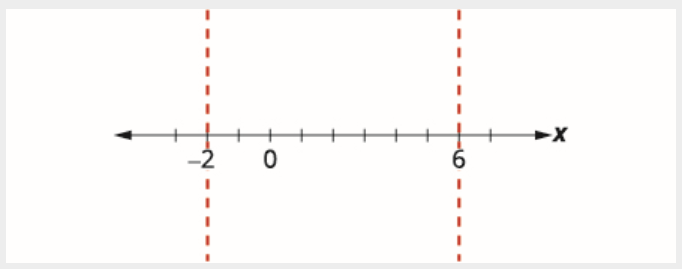
在每个间隔内测试一个值。
| \((-\infty,-2)\) | \((-2,6)\) | \((6, \infty)\) | |
|---|---|---|---|
| \(x+2)\) | \ (-\ infty, -2)\)” style= “vertical-align: middle;” class= “lt-math-5164">
x+2 -3+2 -1 - |
\ (-2,6)\)” style= “vertical-align: middle;” class= “lt-math-5164">
x+2 0+2 2 + |
\ (6,\ infty)\)” style= “vertical-align: middle;” class= “lt-math-5164">
x+2 7+2 9 + |
| \(x-6\) | \ (-\ infty, -2)\)” style= “vertical-align: middle;” class= “lt-math-5164">
x-6 -3-6 -9 - |
\ (-2,6)\)” style= “vertical-align: middle;” class= “lt-math-5164">
x-6 0-6 -6 - |
\ (6,\ infty)\)” style= “vertical-align: middle;” class= “lt-math-5164">
x-6 7-6 1 + |
数字线上方显示每个区间内有理表达式的每个因子的符号。 数字线下方显示商的符号。
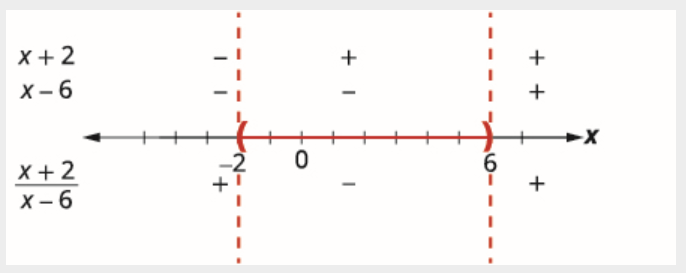
确定不等式正确的间隔。 我们希望商为负数,因此解包括介于 −2 和 6 之间的点。 由于不等式严格小于,因此不包括端点。
我们将解用区间表示法写成 (−2, 6)。
求解并用区间表示法写出解:\(\dfrac{3 x}{x-3}<1\).
- 回答
-
\(\left(-\dfrac{3}{2}, 3\right)\)
求解并用区间表示法写出解:\(\dfrac{3 x}{x-4}<2\).
- 回答
-
\((-8,4)\)
在下一个示例中,分子总是正数,因此有理表达式的符号取决于分母的符号。
求解并用区间表示法写出解:\(\dfrac{5}{x^{2}-2 x-15}>0\).
解决方案
不等式的形式是正确的。
\[\dfrac{5}{x^{2}-2 x-15}>0 \nonumber \]
将分母系数考虑在内。
\[\dfrac{5}{(x+3)(x-5)}>0 \nonumber \]
找到关键点。 当分子为 0 时,商为 0。 由于分子始终为 5,因此商不能为 0。
当分母为零时,商将未定义。
\[\begin{aligned} &(x+3)(x-5)=0\\ &x=-3, x=5 \end{aligned} \nonumber \]
使用临界点将数字线划分为间隔。
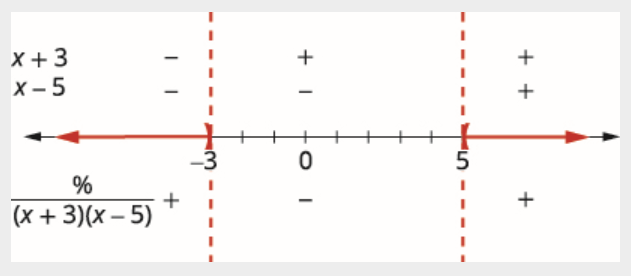
每个间隔中的测试值。 数字线上方显示每个间隔内分母的每个因子的符号。 在数字线下方,显示商的符号。
用间隔表示法写出解。
\[(-\infty,-3) \cup(5, \infty) \nonumber \]
Solve and write the solution in interval notation: \(\dfrac{1}{x^{2}+2 x-8}>0\).
- Answer
-
\((-\infty,-4) \cup(2, \infty)\)
Solve and write the solution in interval notation: \(\dfrac{3}{x^{2}+x-12}>0 \).
- Answer
-
\((-\infty,-4) \cup(3, \infty)\)
The next example requires some work to get it into the needed form.
Solve and write the solution in interval notation: \(\dfrac{1}{3}-\dfrac{2}{x^{2}}<\dfrac{5}{3 x}\).
Solution
\[\dfrac{1}{3}-\dfrac{2}{x^{2}}<\dfrac{5}{3 x} \nonumber \]
Subtract \(\dfrac{5}{3 x}\) to get zero on the right.
\[\dfrac{1}{3}-\dfrac{2}{x^{2}}-\dfrac{5}{3 x}<0 \nonumber \]
Rewrite to get each fraction with the LCD
\[\dfrac{1 \cdot x^{2}}{3 \cdot x^{2}}-\dfrac{2 \cdot 3}{x^{2} \cdot 3}-\dfrac{5 \cdot x}{3 x-x}<0 \nonumber \]
Simplify.
\[\dfrac{x^{2}}{3 x^{2}}-\dfrac{6}{3 x^{2}}-\dfrac{5 x}{3 x^{2}}<0 \nonumber \]
Subtract the numerators and place the difference over the common denominator.
\[\dfrac{x^{2}-5 x-6}{3 x^{2}}<0 \nonumber \]
Factor the numerator.
\[\dfrac{(x-6)(x+1)}{3 x^{2}}<0 \nonumber \]
Find the critical points.
\[\begin{array}{rlrl} {3 x^{2}=0} && {x-6=0} && {x+1=0} \\ {x=0} && {x=6} && {x=-1} \end{array} \nonumber \]
Use the critical points to divide the number line into intervals.
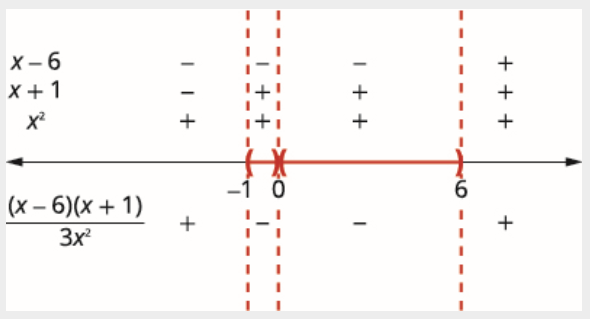
数字线上方显示每个间隔中每个因子的符号。 在数字线下方,显示商的符号。
由于排除 0,因此解是两个\((-1,0) \cup(0,6)\)间隔,\((-1,0)\)和\((0,6)\)。
求解并用区间表示法写出解:\(\dfrac{1}{2}+\dfrac{4}{x^{2}}<\dfrac{3}{x}\).
- 回答
-
\((2,4)\)
求解并用区间表示法写出解:\(\dfrac{1}{3}+\dfrac{6}{x^{2}}<\dfrac{3}{x}\).
- 回答
-
\((3,6)\)
用有理函数求解不等式
在使用有理函数时,知道该函数何时大于或小于特定值有时很有用。 这导致了理性的不平等。
给定函数\(R(x)=\dfrac{x+3}{x-5}\),求出使函数小于或等于 0 的 x 值。
解决方案
我们希望该函数小于或等于 0。
\[R(x) \leq 0 \nonumber \]
用有理表达式代替\(R(x)\)。
\[\dfrac{x+3}{x-5} \leq 0 \quad x \neq 5 \nonumber \]
找到关键点。
\[\begin{array}{rlrl} {x+3=0} && {x-5=0} \\ {x=-3} && {x=5} \end{array} \nonumber \]
使用临界点将数字线划分为间隔。
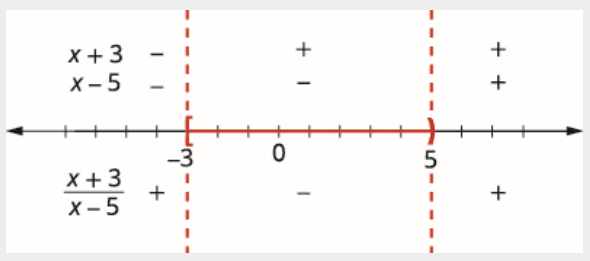
每个间隔中的测试值。 在数字线上方,显示每个间隔中每个因子的符号。 在数字线下方,显示商的符号。 用间隔表示法写出解。 由于 5 被排除在外,因此请勿将其包含在间隔中。
\[[-3,5) \nonumber \]
Given the function \(R(x)=\dfrac{x-2}{x+4}\), find the values of \(x\) that make the function less than or equal to 0.
- Answer
-
\((-4,2]\)
Given the function \(R(x)=\dfrac{x+1}{x-4}\), find the values of \(x\) that make the function less than or equal to 0.
- Answer
-
\([-1,4)\)
In economics, the function \(C(x)\) is used to represent the cost of producing \(x\) units of a commodity. The average cost per unit can be found by dividing \(C(x)\) by the number of items \(x\). Then, the average cost per unit is \(c(x)=\dfrac{C(x)}{x}).
The function\(C(x)=10 x+3000\) represents the cost to produce \(x\), number of items. Find:
- The average cost function, \(c(x)\)
- How many items should be produced so that the average cost is less than $40.
Solution
- \[C(x)=10 x+3000 \nonumber \]
The average cost function is \(c(x)=\dfrac{C(x)}{x})\). To find the average cost function, divide the cost function by \(x\).
\[\begin{aligned} &c(x)=\dfrac{C(x)}{x}\\ &c(x)=\dfrac{10 x+3000}{x} \end{aligned} \nonumber \]
The average cost function is \(c(x)=\dfrac{10 x+3000}{x} \)
- We want the function \(c(x)\) to be less than 40.
\[c(x)<40 \nonumber \]
Substitute the rational expression forc(x).
\[\dfrac{10 x+3000}{x}<40, \quad x \neq 0 \nonumber \]
Subtract 40 to get 0 on the right.
\[\dfrac{10 x+3000}{x}-40<0 \nonumber \]
Rewrite the left side as one quotient by finding the LCD and performing the subtraction.
\[\begin{aligned} \dfrac{10 x+3000}{x}-40\left(\dfrac{x}{x}\right) &<0\\ \dfrac{10 x+3000}{x}-\dfrac{40 x}{x} &<0\\ \dfrac{10 x+3000-40 x}{x} &<0 \\ \dfrac{-30 x+3000}{x} &<0 \end{aligned} \nonumber \]
Factor the numerator to show all factors.
\[\begin{array}{ll} {\dfrac{-30(x-100)}{x}<0} \\ {-30(x-100)=0} && {x=0} \end{array} \nonumber \]
Find the critical points.
\[\begin{array}{rl} {-30 \neq 0} & {x-100=0} \\ &{x=100} \end{array} \nonumber \]
More than 100 items must be produced to keep the average cost below $40 per item.
The function\(C(x)=20 x+6000\) represents the cost to produce \(x\), number of items. Find:
- How many items should be produced so that the average cost is less than $60.
- Answer
-
- \(c(x)=\dfrac{20 x+6000}{x}\)
- More than 150 items must be produced to keep the average cost below $60 per item.
The function\(C(x)=5 x+900\) represents the cost to produce \(x\), number of items. Find:
- How many items should be produced so that the average cost is less than $20.
- Answer
-
- \(c(x)=\dfrac{5 x+900}{x}\)
- More than 60 items must be produced to keep the average cost below $20 per item.


